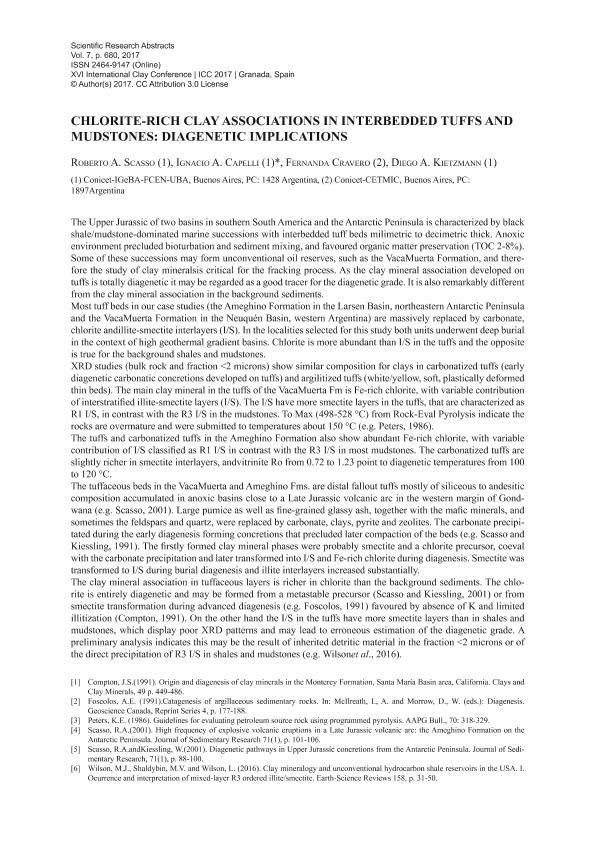Evento
Chlorite-rich clay associations in interbedded tuffs and mudstones: diagenetic implications
Scasso, Roberto Adrian ; Capelli, Ignacio Andrés
; Capelli, Ignacio Andrés ; Cravero, Maria Fernanda
; Cravero, Maria Fernanda ; Kietzmann, Diego Alejandro
; Kietzmann, Diego Alejandro
 ; Capelli, Ignacio Andrés
; Capelli, Ignacio Andrés ; Cravero, Maria Fernanda
; Cravero, Maria Fernanda ; Kietzmann, Diego Alejandro
; Kietzmann, Diego Alejandro
Tipo del evento:
Conferencia
Nombre del evento:
XVI International Clay Conference from the Oceans to Space
Fecha del evento:
17/07/2017
Institución Organizadora:
Sociedad Española de Arcillas;
Título del Libro:
XVI International Clay Conference from the Oceans to Space
Editorial:
Digilabs
ISBN:
978-88-7522-089-1
Idioma:
Inglés
Clasificación temática:
Resumen
The Upper Jurassic of two basins in southern South America and the Antarctic Peninsula is characterized by blackshale/mudstone-dominated marine successions with interbedded tuff beds milimetric to decimetric thick. Anoxicenvironment precluded bioturbation and sediment mixing, and favoured organic matter preservation (TOC 2-8%).Some of these successions may form unconventional oil reserves, such as the VacaMuerta Formation, and thereforethe study of clay mineralsis critical for the fracking process. As the clay mineral association developed ontuffs is totally diagenetic it may be regarded as a good tracer for the diagenetic grade. It is also remarkably differentfrom the clay mineral association in the background sediments.Most tuff beds in our case studies (the Ameghino Formation in the Larsen Basin, northeastern Antarctic Peninsulaand the VacaMuerta Formation in the Neuquén Basin, western Argentina) are massively replaced by carbonate,chlorite andillite-smectite interlayers (I/S). In the localities selected for this study both units underwent deep burialin the context of high geothermal gradient basins. Chlorite is more abundant than I/S in the tuffs and the oppositeis true for the background shales and mudstones.XRD studies (bulk rock and fraction <2 microns) show similar composition for clays in carbonatized tuffs (earlydiagenetic carbonatic concretions developed on tuffs) and argilitized tuffs (white/yellow, soft, plastically deformedthin beds). The main clay mineral in the tuffs of the VacaMuerta Fm is Fe-rich chlorite, with variable contributionof interstratified illite-smectite layers (I/S). The I/S have more smectite layers in the tuffs, that are characterized asR1 I/S, in contrast with the R3 I/S in the mudstones. To Max (498-528 °C) from Rock-Eval Pyrolysis indicate therocks are overmature and were submitted to temperatures about 150 °C (e.g. Peters, 1986).The tuffs and carbonatized tuffs in the Ameghino Formation also show abundant Fe-rich chlorite, with variablecontribution of I/S classified as R1 I/S in contrast with the R3 I/S in most mudstones. The carbonatized tuffs areslightly richer in smectite interlayers, andvitrinite Ro from 0.72 to 1.23 point to diagenetic temperatures from 100to 120 °C.The tuffaceous beds in the VacaMuerta and Ameghino Fms. are distal fallout tuffs mostly of siliceous to andesiticcomposition accumulated in anoxic basins close to a Late Jurassic volcanic arc in the western margin of Gondwana(e.g. Scasso, 2001). Large pumice as well as fine-grained glassy ash, together with the mafic minerals, andsometimes the feldspars and quartz, were replaced by carbonate, clays, pyrite and zeolites. The carbonate precipitatedduring the early diagenesis forming concretions that precluded later compaction of the beds (e.g. Scasso andKiessling, 1991). The firstly formed clay mineral phases were probably smectite and a chlorite precursor, coevalwith the carbonate precipitation and later transformed into I/S and Fe-rich chlorite during diagenesis. Smectite wastransformed to I/S during burial diagenesis and illite interlayers increased substantially.The clay mineral association in tuffaceous layers is richer in chlorite than the background sediments. The chloriteis entirely diagenetic and may be formed from a metastable precursor (Scasso and Kiessling, 2001) or fromsmectite transformation during advanced diagenesis (e.g. Foscolos, 1991) favoured by absence of K and limitedillitization (Compton, 1991). On the other hand the I/S in the tuffs have more smectite layers than in shales andmudstones, which display poor XRD patterns and may lead to erroneous estimation of the diagenetic grade. Apreliminary analysis indicates this may be the result of inherited detritic material in the fraction <2 microns or ofthe direct precipitation of R3 I/S in shales and mudstones (e.g. Wilsonet al., 2016).[1] Compton, J.S.(1991). Origin and diagenesis of clay minerals in the Monterey Formation, Santa María Basin area, California. Clays andClay Minerals, 49 p. 449-486.[2] Foscolos, A.E. (1991).Catagenesis of argillaceous sedimentary rocks. In: McIlreath, I., A. and Morrow, D., W. (eds.): Diagenesis.Geoscience Canada, Reprint Series 4, p. 177-188.[3] Peters, K.E. (1986). Guidelines for evaluating petroleum source rock using programmed pyrolysis. AAPG Bull., 70: 318-329.[4] Scasso, R.A.(2001). High frequency of explosive volcanic eruptions in a Late Jurassic volcanic arc: the Ameghino Formation on theAntarctic Peninsula. Journal of Sedimentary Research 71(1), p. 101-106.[5] Scasso, R.A.andKiessling, W.(2001). Diagenetic pathways in Upper Jurassic concretions from the Antarctic Peninsula. Journal of SedimentaryResearch, 71(1), p. 88-100.[6] Wilson, M.J., Shaldybin, M.V. and Wilson, L. (2016). Clay mineralogy and unconventional hydrocarbon shale reservoirs in the USA. I.Ocurrence and interpretation of mixed-layer R3 ordered illite/smectite.
Palabras clave:
Chlorite
,
Tuffs
,
Diagenesis
,
Upper Jurassic
Archivos asociados
Licencia
Identificadores
Colecciones
Eventos(CETMIC)
Eventos de CENTRO TECNOL.DE REC.MINERALES Y CERAMICA (I)
Eventos de CENTRO TECNOL.DE REC.MINERALES Y CERAMICA (I)
Eventos(IDEAN)
Eventos de INSTITUTO DE ESTUDIOS ANDINOS "DON PABLO GROEBER"
Eventos de INSTITUTO DE ESTUDIOS ANDINOS "DON PABLO GROEBER"
Eventos(IGEBA)
Eventos de INSTITUTO DE GEOCIENCIAS BASICAS, APLICADAS Y AMBIENTALES DE BS. AS
Eventos de INSTITUTO DE GEOCIENCIAS BASICAS, APLICADAS Y AMBIENTALES DE BS. AS
Citación
Chlorite-rich clay associations in interbedded tuffs and mudstones: diagenetic implications; XVI International Clay Conference from the Oceans to Space; Granada; España; 2017; 680-680
Compartir



